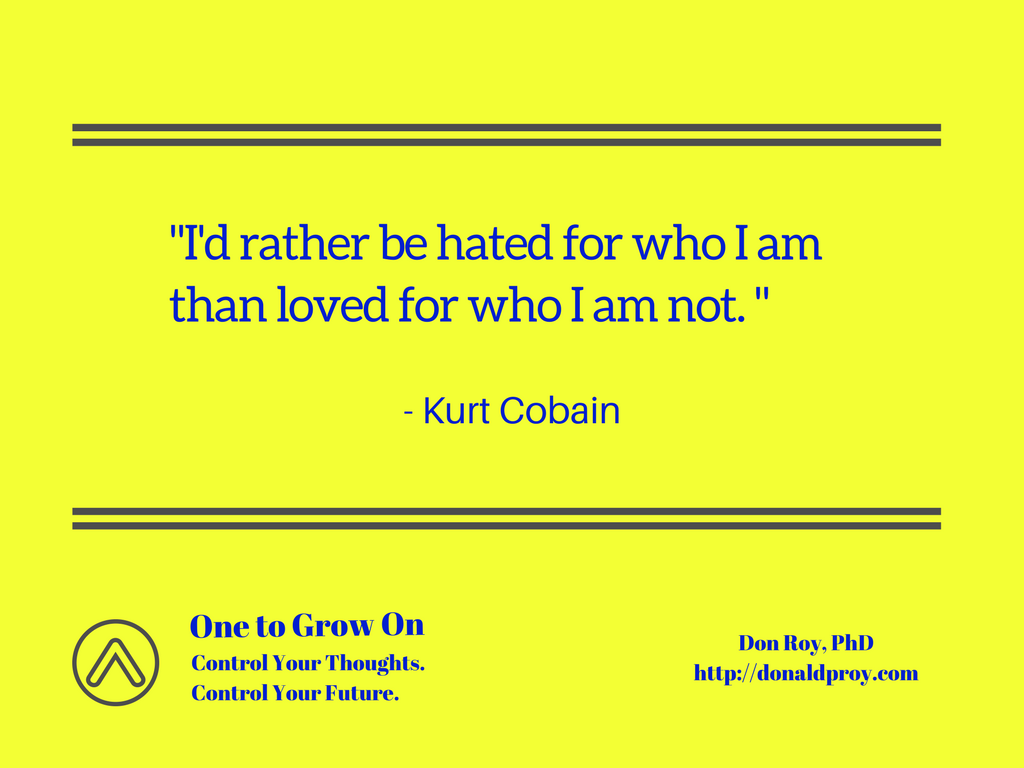One of the hardest lessons for me to accept as a young marketer was that my company’s offerings were not for everyone. On top of that, there were some non-customers that simply disliked us. Maybe they had a bad experience with our company years ago. Or, a competitor made disparaging remarks about our company. In some instances, it was that people disliked our product, perceiving it to be inferior relative to competition. Whatever the source of negative beliefs, our products were not going to wind up in their shopping carts. Safe to say people in this camp were not fans… nor were they going to be.
The sooner you accept the fact that you will have detractors, the sooner you will be freed up to create value for those people who believe in you. I suppose it is human nature to want to be accepted and liked. The reality is universal acclaim and support is not going to happen. Do not compromise your beliefs or integrity in an attempt to win over naysayers.
The late Kurt Cobain succinctly states the importance of being your authentic self. When you “play it down the middle” to not turn off anyone, it is very likely that you will also fail to turn on people.
 Aim to Please
Aim to Please
Attempting to create broad appeal seems to be a logical strategy. Product acceptance odds increase the larger the target market. Factors influencing our attempts to aim to please include:
- Desire to be liked. Receiving positive feedback validates our work and strokes our ego.
- Potential to grow. The wider net we cast, the greater the possibility of our brand and message being spread via word-of-mouth.
- Fear. We may be concerned what detractors might do and thus attempt to minimize interactions with them. Will they have silent indifference, or will they be bent on communicating their dissatisfaction to anyone who will listen?
We can fool ourselves into seeing positive benefits and take precautions against stirring the pot of negativity. Unfortunately, the end result could be a personal brand without distinction.
Take a Stand
The alternative course of action to playing it safe is to take a stand. We need to look no further than the world of product brands to realize staking a position is a necessity. Product marketers segment audiences to appeal to those customers who they can best serve. We must take the same approach. The goal need not be create a large audience but rather a committed audience. Kevin Kelly, founding editor of Wired magazine, espouses a belief that the goal of a business serving individual markets should be to build an audience of 1,000 die-hard fans. This core customer group will buy, advocate, and refer on your behalf. The headcount may not be gaudy, but it represents a high quality group of believers.
If you think 1,000 committed fans is too small a number, we can find examples of popular brands also being polarizing brands. Look to the NFL for an example. The Dallas Cowboys and New England Patriots are two of the most disliked teams in the league based on fan surveys. These same two franchises are also among the most popular. The top four players in jersey sales for 2016 were from these teams (three Cowboys, one Patriot). These teams evoke love-hate reactions from many fans.
Decide to Divide
If you have been clinging to the notion that you can attract more followers to your brand, it is OK to hang on to that thought. It is also OK to entertain a goal of creating detractors. Do not go out of your way to inflame people and encourage haters. At the same time, avoid being conservative so that you do not offend or alienate others. Follow the words of Kurt Cobain and embrace your authentic brand. Some will be attracted to it; others will be driven away. Both outcomes are acceptable as long as you consistently live your brand.
Image credit: Flickr/Adam McGhee via Creative Commons license

